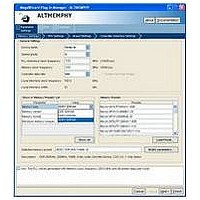IPR-HPMCII Altera, IPR-HPMCII Datasheet - Page 99

IPR-HPMCII
Manufacturer Part Number
IPR-HPMCII
Description
IP CORE Renewal Of IP-HPMCII
Manufacturer
Altera
Datasheet
1.IP-HPMCII.pdf
(176 pages)
Specifications of IPR-HPMCII
Software Application
IP CORE, Memory Controllers, SDRAM
Supported Families
Arria II GX, HardCopy III, Stratix III, Stratix IV
Core Architecture
FPGA
Core Sub-architecture
Arria, HardCopy, Stratix
Rohs Compliant
NA
Lead Free Status / RoHS Status
na
- Current page: 99 of 176
- Download datasheet (4Mb)
Chapter 6: Functional Description—High-Performance Controller
Block Description
December 2010 Altera Corporation
Control Logic
Error Correction Coding (ECC)
f
Bus commands control SDRAM devices using combinations of the mem_ras_n,
mem_cas_n, and mem_we_n signals. For example, on a clock cycle where all three signals
are high, the associated command is a no operation (NOP). A NOP command is also
indicated when the chip select signal is not asserted.
SDRAM bus commands.
Table 6–2. Bus Commands
The DDR3 SDRAM HPC must open SDRAM banks before it accesses the addresses in
that bank. The row and bank to be opened are registered at the same time as the active
(ACT) command. The DDR3 SDRAM HPC closes the bank and opens it again if it
needs to access a different row. The precharge (PCH) command closes only a bank.
The primary commands used to access SDRAM are read (RD) and write (WR). When
the WR command is issued, the initial column address and data word is registered.
When a RD command is issued, the initial address is registered. The initial data
appears on the data bus 5 to 11 clock cycles later. This delay is the column address
strobe (CAS) latency and is due to the time required to read the internal DRAM core
and register the data on the bus. The CAS latency (of 6) depends on the speed of the
SDRAM and the frequency of the memory clock. In general, the faster the clock, the
more cycles of CAS latency are required. After the initial RD or WR command,
sequential reads and writes continue until the burst length is reached. DDR3 SDRAM
devices support fixed burst lengths of 4 or 8 data cycles or an on-the-fly mode where
the controller can request a burst of 4 or 8 for each read or write command. This
on-the-fly mode is the only mode supported. The auto-refresh command (ARF) is
issued periodically to ensure data retention. This function is performed by the DDR3
SDRAM HPC.
The load mode register command (LMR) configures the SDRAM mode register. This
register stores the CAS latency, burst length, and burst type.
For more information, refer to the specification of the SDRAM that you are using.
The optional ECC logic comprises an encoder and a decoder-corrector, which can
detect and correct single-bit errors and detect double-bit errors. The ECC logic uses an
8-bit ECC for each 64-bit message. The ECC logic has the following features:
■
No operation
Active
Read
Write
Precharge
Auto refresh
Load mode register
Hamming code ECC logic that encodes every 64-bits of data into 72-bits of
codeword with 8-bits of Hamming code parity bits
Command
Acronym
LMR
NOP
PCH
ACT
ARF
WR
RD
Section II. DDR3 SDRAM Controller with ALTMEMPHY IP User Guide
ras_n
High
High
High
Low
Low
Low
Low
External Memory Interface Handbook Volume 3
Table 6–2
shows the standard
cas_n
High
High
High
Low
Low
Low
Low
we_n
High
High
High
High
Low
Low
Low
6–5
Related parts for IPR-HPMCII
Image
Part Number
Description
Manufacturer
Datasheet
Request
R

Part Number:
Description:
IP NIOS II MEGACORE RENEW
Manufacturer:
Altera
Datasheet:

Part Number:
Description:
IP CORE Renewal Of IP-XAUIPCS
Manufacturer:
Altera
Datasheet:

Part Number:
Description:
IP CORE Renewal Of IP-10GETHERNET
Manufacturer:
Altera
Datasheet:

Part Number:
Description:
IP CORE Renewal Of IP-ASI
Manufacturer:
Altera
Datasheet:

Part Number:
Description:
IP CORE Renewal Of IP-CIC
Manufacturer:
Altera
Datasheet:

Part Number:
Description:
IP CORE Renewal Of IP-CRC
Manufacturer:
Altera
Datasheet:

Part Number:
Description:
IP CORE Renewal Of IP-ED8B10B
Manufacturer:
Altera
Datasheet:

Part Number:
Description:
CPLD, EP610 Family, ECMOS Process, 300 Gates, 16 Macro Cells, 16 Reg., 16 User I/Os, 5V Supply, 35 Speed Grade, 24DIP
Manufacturer:
Altera Corporation
Datasheet:

Part Number:
Description:
CPLD, EP610 Family, ECMOS Process, 300 Gates, 16 Macro Cells, 16 Reg., 16 User I/Os, 5V Supply, 15 Speed Grade, 24DIP
Manufacturer:
Altera Corporation
Datasheet:

Part Number:
Description:
Manufacturer:
Altera Corporation
Datasheet:










